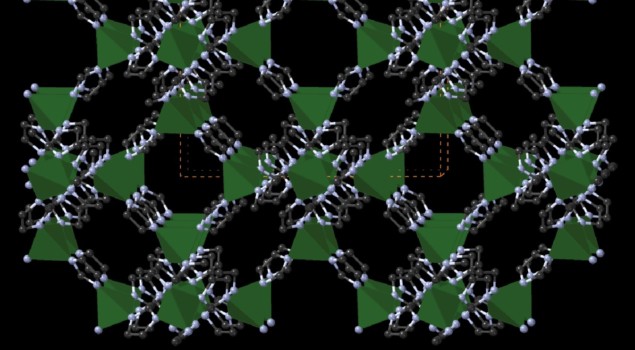Materials absorb huge impacts by forcing water through nanopores
18 May 2021
High impact: illustration of the structure of a zeolitic imidazolate framework. (Courtesy: François-Xavier Coudert/CC BY 4.0)
A study of how water is forced into the nanoscopic pores of materials has led to the design of highly efficient energy absorbers that could find a range of applications including body armour.
The work was done by researchers in UK and Belgium, who have also developed a new set of guidelines for designing reusable, tailorable, and highly efficient energy absorbers.
Materials that are good at absorbing energy during mechanical impacts have a wide range of applications from military body armour to dampening industrial vibration. In state-of-the-art systems, these materials can rely on a range of processes including plastic deformation; the buckling of rigid hollow cells; and dissipation through viscoelastic polymers. However, these approaches often face a trade-off between reusability and energy absorption efficiency.
A promising route forward lies in the pressurized intrusion of liquid water into hydrophobic, nanoporous materials – including metal-organic frameworks (MOFs). As the pressure generated by a mechanical impact forces water into the hydrophobic nanopores, the liquid breaks up into nanoscale clusters. Due to the vast surface areas of these materials, this is an energy-intensive process as the water’s mechanical energy is rapidly converted into surface energy as it enters the pores. Afterward an impact, the water is forced back out of the material, which is ready to use again.
ZIFs and MOFs
This latest research was led by Yueting Sun at the University of Birmingham and explored how this process occurs within zeolitic imidazolate frameworks (ZIFs). These are MOFs that contain transition metal ions arranged in tetrahedral patterns that are bridged by organic ligands. So far, ZIFs with hundreds of possible molecular arrangements have been characterized. Some contain nanoscopic cages of atoms, while others contain arrays of straight channels.READ MORE

To harness the full potential of ZIFs, the researchers used a combination of experiments and molecular simulations to recreate the intrusion and extrusion of water following realistic, high-energy impacts. Their observations revealed that within ZIFs containing nanocages, energy absorption efficiency improves substantially with the increasing strain rates driven by faster water intrusion. This advantage was not observed in ZIFs containing channels.
The team found that this behaviour occurs because clusters of water molecules have an extremely tight window of time over which they can form within the hydrophobic nanocages – lasting just a few nanoseconds. As a result, both water intrusion pressure and energy absorption density are driven up by the high strain caused by high-energy impacts – something that does not occur when water clusters along channels. From these insights, Sun and colleagues set out new guidelines for designing effective and reusable energy absorbing devices, which can be precisely tailored to specific applications.
The research is described in Nature Materials.
Sam Jarman is a science writer based in the UK.
FROM PHYSICSWORLD.COM 7/9/2023

Δεν υπάρχουν σχόλια:
Δημοσίευση σχολίου